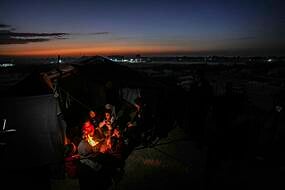A volcano that has already destroyed nearly 1,000 buildings on a Spanish island has increased its explosive power, roaring louder and spewing thicker lava out of its main vent.
The volcanic eruption started on September 19 and has forced the evacuation of more than 6,000 residents of La Palma in the Canary Islands.
Some 946 houses have been destroyed and nearly 100 more damaged, while farmers are struggling to keep the surviving banana plantations irrigated after lava flows destroyed roads and water pipes.
Vídeo de la erupción a las 11.30 h (hora canaria) / Video of the eruption at 11.30 (Canarian hour) #lapalma #erupcion #eruption pic.twitter.com/V0AgzcbCfk
— INVOLCAN (@involcan) October 5, 2021
Advertisement
The Canary Islands Volcanology Institute (Involcan) said on Tuesday that activity in the volcano had become “explosive, with falling pyroclasts and bombs”.
A video released by the institute the night before showed a block of molten rock that had hit against a wall more than a kilometre from the vent, a sign of the explosive activity.
According to Involcan’s calculations, the volcano has emitted at least 250,000 tons of sulphur dioxide and 35 million cubic meters of magma.

Pictures captured the thicker lava that emerged from the main vent in greater quantities after the surrounding cone collapsed again on Monday.
Experts are watching if the downhill path of the lava will follow the previous flows or if it will expand into other areas, spreading the destruction.
After meandering for six kilometres, the lava has been tumbling since last Friday to the Atlantic Ocean. By Tuesday, a peninsula that has been forming has extended the island by 30 hectares, or the equivalent of about 42 football fields.

The island’s tourism chief, Raul Camacho, said on Tuesday that the island remained open for tourists, calling on visitors to keep arriving despite the eruption because their spending is needed to revive the economy.
He said La Palma “is a safe island where there is life, where pupils go to school, where the baker keeps delivering bread every day”.
He added that about 10% of the island is affected by the eruptions.
“Life is normal in the rest of the island,” he said.







